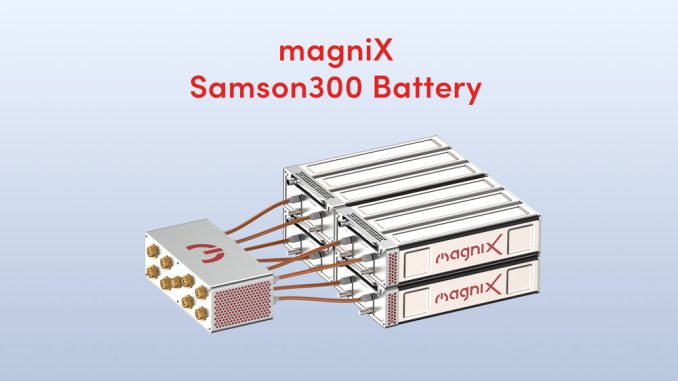
magniX has announced the launch of Samson300 , the first in a new battery product line focused on maximising energy density for greater range and larger payloads in electric and hybrid-electric aviation applications.
According to the company, the key features of magniX Samson batteries include: energy density of 300 Watt hours per kilogram (Wh/kg); battery cycle life of over 1,000 full-depth discharge cycles to reduce operating costs; patented safety technologies, including cell level protections from thermal runaway and ability to store batteries for long periods at zero charge; fast aircraft turnaround time, with active on ground cooling during charging, and the option for passive cooling in flight, minimizing weight and complexity in the aircraft; integrated power electronics and distribution system for better power management supply to the propulsion system; modular battery architecture to power larger aircraft and allow for simple replacement; and comprehensive system designed for certification under aviation regulations
“magniX’s Samson batteries represent a breakthrough for magniX and electric aviation,” said Ben Loxton, VP of Energy Storage Systems (ESS) and the NASA Electric Powertrain Flight Demonstration (EPFD) Program at magniX. “With unrivalled energy density, cycle life, and safety features, magniX’s Samson batteries will help to unlock the tremendous potential of electric flight – enabling many eVTOLs and electric programs on the edge of viability to become viable.”
According to Reed Macdonald, CEO of magniX. “With the development of our Samson batteries, magniX can now offer customers a fully integrated electric powertrain, and it’s just the beginning. The roadmap to an energy density of 400Wh/kg or more is looking very promising.”
Meanwhile, the company has also announced progress on its work with NASA.
“At a simulated 27,500 feet inside an altitude chamber at NASA’s Electric Aircraft Testbed (NEAT) facility, engineers at magniX recently demonstrated the capabilities of a battery-powered engine that could help turn hybrid electric flight into a reality,” said the company. “This milestone, completed in April 2024, marks the end of the first phase in a series of altitude tests at the facility under NASA’s Electrified Powertrain Flight Demonstration (EPFD) project. EPFD brings together expertise from NASA and various industry partners to test the feasibility of hybrid electric propulsion for future commercial aircraft.

“At higher altitudes, electrified aircraft propulsion systems will be exposed to thinner air and greater temperature shifts that could negatively impact performance. The initial round of tests focused on investigating the effects of temperature and high voltage on the electric engine when operating at flight levels. Researchers conducted partial discharge tests, which examine the strength of the system’s electrical insulation, to help minimize risks of failure that might occur due to excess stress on the components.
“They also investigated the engine’s thermal management system to better understand how heat is safely and effectively transferred throughout the machine. Under EPFD, magniX is retrofitting a De Havilland Dash 7 aircraft with a new hybrid electric propulsion system that combines traditional turbo-propellor engines with electric motors.This vehicle will be used to demonstrate fuel burn and emission reductions in regional aircraft carrying up to 50 passengers, helping advance NASA’s mission to make air travel more sustainable.”
https://www.magnix.aero/detail/magnix-launches-revolutionary-battery-product
NASA, MagniX Altitude Tests Lay Groundwork for Hybrid Electric Planes

